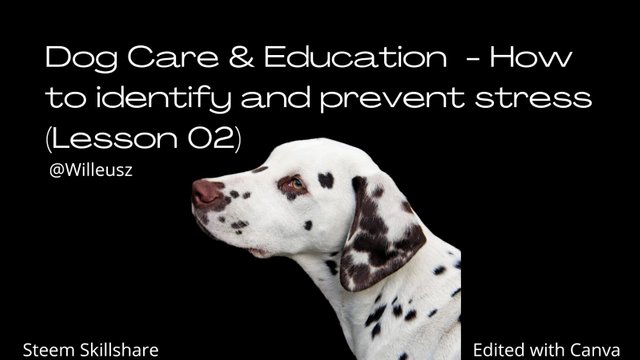Dog Care & Education - How to Identify and Prevent Stress (Lesson 02) 15% to Steem Skillshare

Hello dear Stemian freinds. It is a pleasure to write again to you.
Today we are continuing with our lessons on the care and education of our dogs. I want to talk to you about a very common problem that many times we do not pay enough attention to or do not fully understand. It is about stress in our dogs because, like us humans, they also get stressed.
Stress is nothing more than the accumulated tension due to situations that can occur in the daily life of our pets. These situations can lead from erratic or abnormal behaviors to health problems and changes in the personality of our pets.
If we do not do something to help them overcome these situations as soon as we detect them, they can trigger bigger problems in the future.
How can we know if our dog is stressed?
For this, we must know the personality of our friend, be attentive and observe the behavioral changes in our dog.
- It growls when touched, if our dog reacts aggressively to contact it is clear evidence of stress.
- Loss of appetite, apathy when eating.
- Excessive yawning.
- Constant gasps.
- Sudden hair loss.
- Diarrhea or vomiting.
- Apathy, negativity to play, go out, or exercise.
- Skin problems, scratching excessively and convulsively.
- Irrational fears and panic attacks.
- Making a mess.
All these symptoms must be seen as a set to be able to recognize the stress of our friend. Once we are aware that our dog has a problem, we can follow the following recommendations to prevent and reduce his stress levels:
- Respect the spaces, both the space of our pet at home and their exploration space during walks. Remember to walk long enough, give them enough freedom to explore, sniff and experience their environment. If they walk with a leash, the recommended length is no less than a meter and a half, this will increase the feeling of freedom and reduce stress levels.
- Understand the behaviors, personality, and needs of our dog, for this it is best to follow the recommendations of the veterinarian, depending on the breed, size, and age of the dog, and regarding the number of exercises, type of food, nutrients that your dog needs and even toys that your dog needs.
- Remember that each dog has its personality, not everyone likes to play ball or look for the stick, if you force him to do things that it does not like, you will increase its stress levels.
- Avoid conflict situations, if you already know your dog and you know what kind of situations stress it out, it is best to avoid them. For example, my dog is stressed when bypassing workers working with large tools, whether they are noisy or not, and it is very common to find this type of situation living in the middle of the city. So I simply cross to the other side of the street to avoid them. When he was younger he was afraid of skaters, so in the afternoons we went to the skate park and played closer and closer, so little by little he became familiar and lost his fear completely.
- Avoid conflictive situations around our dog and take care of body language, they can channel these situations as punishment or feel that the conflict is with them.
- We must be the refuge of our dogs, when he feels fear, provide support, caress them and make them understand that everything is fine and that nothing bad is happening.
- Respect the walking schedules, you have to give them enough freedom to play and socialize. They also get bored of being at home all the time, especially if they live in apartments. Socializing them will help not only to avoid stress but also to develop a healthy personality and to get along with other people and other pets.
- Take care of your relationship with your dog, avoid excessive and unnecessary punishments, a good way to avoid unnecessary punishments is with positive stimuli, redirecting the behavior, congratulating him when he does something good when he obeys an order. For example, teach him to look for a toy and if you see him biting something he shouldn't, tell him "no" but at the same time show him the toy or point to it. They have a well-developed sense of belonging, in addition, they will learn what things they should bite and which ones should not.
I hope this information will be helpful for you, remember always in case of stronger symptoms you need to contact the veterinarian. If you want to read the previous lesson, here is the link. Greetings from Argentina!
Español:
Hola queridos amigos de Stemian. Es un placer volver a escribirle.
Hoy continuamos con nuestras lecciones sobre el cuidado y educación de nuestros perros. Quiero hablarte de un problema muy común al que muchas veces no prestamos suficiente atención o no entendemos del todo. Se trata de estrés en nuestros perros porque, al igual que los humanos, también se estresan.
El estrés no es más que la tensión acumulada debido a situaciones que pueden ocurrir en el día a día de nuestras mascotas. Estas situaciones pueden derivar desde comportamientos erráticos o anormales hasta problemas de salud y cambios en la personalidad de nuestras mascotas.
Si no hacemos algo para ayudarles a superar estas situaciones en cuanto las detectemos, pueden desencadenar problemas mayores en el futuro.
¿Cómo podemos saber si nuestro perro está estresado?
Para ello, debemos conocer la personalidad de nuestro amigo, estar atentos y observar los cambios de comportamiento en nuestro perro.
- Gruñe cuando lo tocan, si nuestro perro reacciona de forma agresiva al contacto es una clara evidencia de estrés.
- Pérdida del apetito, apatía al comer.
- Bostezos excesivos.
- Jadeos constantes.
- Caída repentina del cabello.
- Diarrea o vómitos.
- Apatía, negatividad para jugar, salir o hacer ejercicio.
- Problemas de piel, rascado excesivo y convulsivo.
- Miedos irracionales y ataques de pánico.
- Haciendo un lío.
Todos estos síntomas deben verse como un conjunto para poder reconocer el estrés de nuestro amigo. Una vez que somos conscientes de que nuestro perro tiene un problema, podemos seguir las siguientes recomendaciones para prevenir y reducir sus niveles de estrés:
- Respete los espacios, tanto el espacio de nuestra mascota en casa como su espacio de exploración durante los paseos. Recuerde caminar lo suficiente, deles suficiente libertad para explorar, oler y experimentar su entorno. Si caminan con correa, la longitud recomendada no es menor de metro y medio, esto aumentará la sensación de libertad y reducirá los niveles de estrés.
- Comprender los comportamientos, personalidad y necesidades de nuestro perro, para ello lo mejor es seguir las recomendaciones del veterinario, en función de la raza, tamaño y edad del perro, y respecto a la cantidad de ejercicios, tipo de alimento, nutrientes. que su perro necesita e incluso los juguetes que necesita su perro.
- Recuerda que cada perro tiene su personalidad, no a todo el mundo le gusta jugar a la pelota o buscar el palo, si lo obligas a hacer cosas que no le gustan, aumentarás sus niveles de estrés.
- Evita situaciones conflictivas, si ya conoces a tu perro y sabes qué tipo de situaciones lo estresan, lo mejor es evitarlas. Por ejemplo, mi perro se estresa al pasar por alto a trabajadores que trabajan con herramientas grandes, sean ruidosos o no, y es muy común encontrar este tipo de situación viviendo en medio de la ciudad. Así que simplemente cruzo al otro lado de la calle para evitarlos. Cuando era más joven le tenía miedo a los patinadores, así que por las tardes íbamos al parque de patinaje y jugábamos cada vez más cerca, así que poco a poco se fue familiarizando y perdiendo el miedo por completo.
- Evita situaciones conflictivas en torno a nuestro perro y cuida el lenguaje corporal, pueden canalizar estas situaciones como castigo o sentir que el conflicto está con ellos.
- Debemos ser el refugio de nuestros perros, cuando sienta miedo, brindarles apoyo, acariciarlos y hacerles entender que todo está bien y que no pasa nada malo.
- Respeta los horarios de caminata, tienes que darles suficiente libertad para jugar y socializar. También se aburren de estar en casa todo el tiempo, sobre todo si viven en apartamentos. Socializarlos ayudará no solo a evitar el estrés, sino también a desarrollar una personalidad saludable y a llevarse bien con otras personas y otras mascotas.
- Cuida tu relación con tu perro, evita castigos excesivos e innecesarios, una buena forma de evitar castigos innecesarios es con estímulos positivos, redireccionando el comportamiento, felicitándolo cuando hace algo bueno cuando obedece una orden. Por ejemplo, enséñele a buscar un juguete y si lo ve mordiendo algo que no debería, dígale "no" pero al mismo tiempo enséñele el juguete o señale. Tienen un sentido de pertenencia bien desarrollado, además, aprenderán qué cosas deben morder y cuáles no.
*Thank you so much for all the support, the 15% of the profits from this publication will benefit the Steem Skillshare community.
cc: @milakz
cc: @Daytona475


Gracias por un artículo tan completo, detallado y lleno de valor. Es importante tener en cuenta estas señales y sugerencias para el buen cuidado de nuestras mascotas. Muchas gracias por tu aporte!
#affable
Muchas gracias amiga, así es muchas veces asociamos esas actitudes a falta de entrenamiento o disciplina y resulta que es mucho más complejo que eso. Saludos!
Hello, @willeusz. Nice post. Are you a vatenarian?
Thank you my friend, no I am not a veterinarian, i just like too read about it and I am trying all the time to understand my dog.